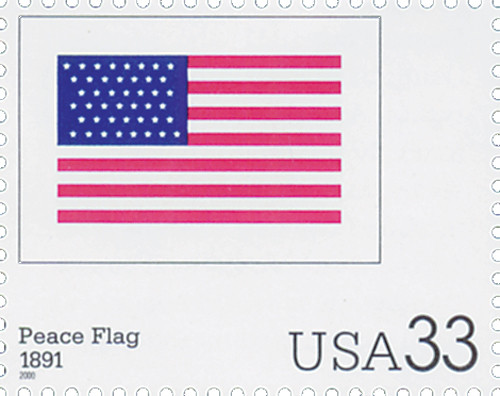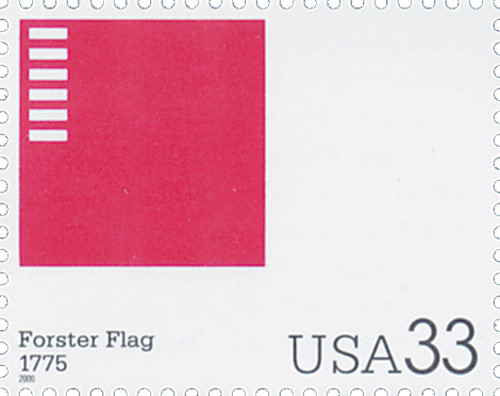
2000 33c The Stars and Stripes: Bennington Flag
# 3403l - 2000 33c The Stars and Stripes: Bennington Flag
$1.75 - $4.95
U.S. #3403l
33¢ Bennington Flag (circa 1820)
The Stars and Stripes
33¢ Bennington Flag (circa 1820)
The Stars and Stripes
Issue Date: June 14, 2000
City: Baltimore, MD
Quantity: 4,000,000
Printed by: Banknote of America
Printing Method: Lithographed
Perforations: 10.5 x 11
Color: Multicolored
City: Baltimore, MD
Quantity: 4,000,000
Printed by: Banknote of America
Printing Method: Lithographed
Perforations: 10.5 x 11
Color: Multicolored
The Stars and Stripes set of 20 stamps chronicles the development of the American flag from Colonial times to the present. Each flag has an interesting story behind it.
Like many of the Revolutionary War-era flags, the Bennington Flag features 13 stars and 13 stripes to symbolize the number of American colonies rebelling against Great Britain. The Bennington Flag is easily identifiable by the large “76” in the canton, which indicates the year the Declaration of Independence was signed.
The flag is most closely associated with the Battle of Bennington, which took place on August 16, 1777, in Walloomsac, New York. A force of 2,000 militiamen – primarily from nearby New Hampshire and Massachusetts – were joined by members of the Green Mountain Boys. They defeated a detachment of General John Burgoyne’s army. The Battle of Bennington was an important victory – Burgoyne’s army lost nearly 1,000 men, Indian tribes who once supported him now abandoned him, and his supply line was broken. These factors helped lead to Burgoyne’s eventual surrender at Saratoga.
U.S. #3403l
33¢ Bennington Flag (circa 1820)
The Stars and Stripes
33¢ Bennington Flag (circa 1820)
The Stars and Stripes
Issue Date: June 14, 2000
City: Baltimore, MD
Quantity: 4,000,000
Printed by: Banknote of America
Printing Method: Lithographed
Perforations: 10.5 x 11
Color: Multicolored
City: Baltimore, MD
Quantity: 4,000,000
Printed by: Banknote of America
Printing Method: Lithographed
Perforations: 10.5 x 11
Color: Multicolored
The Stars and Stripes set of 20 stamps chronicles the development of the American flag from Colonial times to the present. Each flag has an interesting story behind it.
Like many of the Revolutionary War-era flags, the Bennington Flag features 13 stars and 13 stripes to symbolize the number of American colonies rebelling against Great Britain. The Bennington Flag is easily identifiable by the large “76” in the canton, which indicates the year the Declaration of Independence was signed.
The flag is most closely associated with the Battle of Bennington, which took place on August 16, 1777, in Walloomsac, New York. A force of 2,000 militiamen – primarily from nearby New Hampshire and Massachusetts – were joined by members of the Green Mountain Boys. They defeated a detachment of General John Burgoyne’s army. The Battle of Bennington was an important victory – Burgoyne’s army lost nearly 1,000 men, Indian tribes who once supported him now abandoned him, and his supply line was broken. These factors helped lead to Burgoyne’s eventual surrender at Saratoga.










